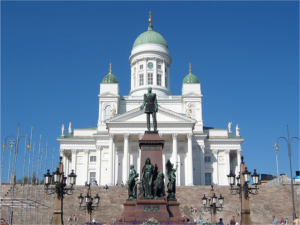
You might know me as a writer, a judge, and a life-long Duluthian. You may also know that, over the past two decades, I‘ve researched, written, and published two historical novels about the Finns. As I type this piece, I’m presently at work on another novel concerning Finnish history and immigration. When all is said and done I’ll have devoted more than twelve years to my Finnish-themed novels. Folks often ask, “If you’re not Finnish, why do you write about the Finns?” Given that Finland recently celebrated 100 years of nationhood (on December 6th, 2017) maybe now’s a good time to answer that question.
I grew up with Finns. As a thoroughly diluted American (Slovenian, English, Welsh, and German with a bit of French, Dutch, Scots, and Irish tossed in for good measure), when I befriended two 100% Finnish boys in 6th grade, I was, given my mutt-like bloodlines, curious. But I didn’t question my new pals’ ethnic purity right off. It wasn’t until the three of us set out to build a log cabin on the Tynjala ancestral farm near Palo when I began to ponder my friends’ Finnishness. During breaks from cutting and peeling and stacking logs I wandered the farm’s abandoned hayfields. As I walked, I took notice of glacial rocks piled high in the fields and wondered: “Who were these people and why did they try to farm this godforsaken land?” Even city kids understand the basics of agriculture: you need ample rain, good soil, a long growing season, and hot sun to be successful. The little Finnish farm in Palo had none of these attributes except ample rain, which, of course, bred ample black flies and mosquitoes and little else. As our makeshift cabin took shape, I puzzled over the hardscrabble lives of those who carved a farm out of forest. But I did not, in my imagined stories, discover anything worth putting down on paper.
In 2000, I stumbled across the tale of Olli Kinkkonen, a Finn found hanging from a tree in Duluth’s Lester Park in 1918. The police ruled Olli’s death a suicide. In my view, the facts pointed to something more sinister. Researching Kinkkonen’s life and times, I became captivated by Finnish immigrant history. Before I knew what hit me, I was penning a broad-shouldered yarn I had no business writing. Once Suomalaiset was in print I feared the worst. Who was I to write the story of the Finns coming to North America? I waited for criticism from the Finnish American community. None came. I breathed a sigh of relief and went on to other projects. I was content−until Gerry Henkel, a Finnish American friend pulled me aside for a “chat”−to leave the Finns alone. I had no further interest in exploring Finnish history in a fictional context. But Gerry convinced me that there was a larger story waiting to be told. What that story was, Gerry left it to me to discover.
I struggled as to what theme could be compelling enough to prompt me to write another book about the Finns. Then it hit me: Karelian Fever, the emigration of thousands of Finns from North America to the U.S.S.R., could fuel a novel. I had an inkling that there was a more complex tale to be told than simply regurgitating themes surrounding Karelian Fever. But what other aspects of Finnish history could be fleshed out? Some topics seemed obvious: many writers have explored the U.S.S.R.’s invasion of Finland in 1939. To add another fictional accounting of the Winter War atop an existing mountain of similar stories seemed meritless. Then it dawned on me: No one has explored why the Finns cast their fate with the Nazis during the war. With Gerry’s encouragement, my second Finn book, Sukulaiset, found its way into print. Once again, I waited for criticism but the storm of protest never materialized. Finns remained appreciative of my treatment of their history, culture, and national identity. Even so, after Sukulaiset was published, I tried to put aside my fondness for the Finns.
Except. Lingering in the back of my mind was a question I’d left unexplored:
Why did all those Finns leave Finland in the first place?
This morning, I’m at my iMac in my writing studio cobbling together an answer to my question. The answer is taking shape in the form of Kotimaa (Homeland), the final novel in my Finnish trilogy. In my effort to understand why Finns left Finland in droves at the end of the 19th century, I find myself juxtaposing historic emigration upon contemporary events. Trying to comprehend the past, I’m compelled to examine the present. I peruse newspaper articles detailing the political handwringing of nations−including boisterous debates taking place in Finland−as world leaders consider the demands of beleaguered refugees; refugees who don’t look, talk, or worship like the folks inhabiting the homelands being called upon to provide sanctuary.
As the Finns−a people once derided as being clannish, standoffish, and unable to assimilate−debate how to respond to dark skinned Moslems seeking shelter and safety from terrorism, war, genocide, and despotic rule within Finland’s borders, I’ll answer the question of why within the context of the plot and dialogue of a historical novel, letting my readers determine whether my response rings true.
Happy 100th Birthday, Finland.
(c) Mark Munger 2018
*Happy Centennial (at least according to Google translate). This essay first appeared in edited form in the Duluth News Tribune and was reprinted with permission in the Finnish American Reporter.


